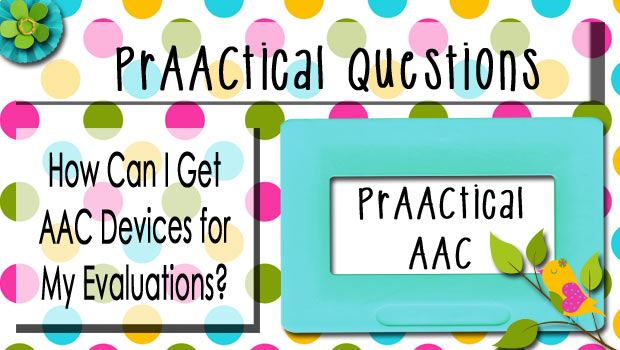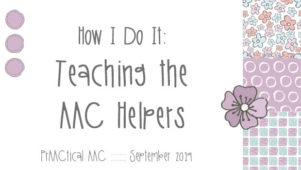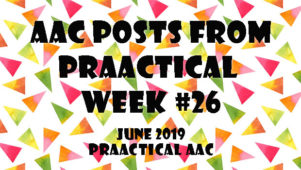PrAACtical Questions: How Can I Get AAC Devices for My Evaluations?

/praactical%20questions%20chalkboard.jpg)
PrAACtical Questions is an occasional series in which we address concerns that our graduate students and others have posed to us about the real world challenges of implementing AAC. This post focuses on AAC evaluations.
–
The Question: I don’t have many SGDs in my school/clinic. How can I evaluate someone for AAC?
—
The Situation: A clinician with a good background in using the feature match process for AAC evaluations needs to evaluate a student with severe speech difficulties. Her center has a few AAC devices that she can use for this evaluation but there are a few others that she doesn’t have which are appropriate to consider. There isn’t much chance that she will be given approval to purchase those. How can we get the student an appropriate AAC evaluation?
Some Ideas: This is a fairly common problem since few practicing SLPs have access to all of the SGDs, iDevices, apps, and other AT that they need for their evaluations. Here are some options.
1. Borrow the equipment: Some states have lending libraries through their state tech act programs. Not sure how to reach your state tech act program? Here’s a list. Once you’ve established a solid relationship with AAC vendors, some will lend equipment for evaluations and even trial use. We’ve had wonderful experiences with this from PRC, Tobii/ATI, Saltillo, and others.
–
2. Collaborate with colleagues: On occasion, we’ve collaborated with colleagues to fill in equipment gaps. Before we had our first iPad, a colleague came and brought hers to an AAC eval or two so that we could try out the physical access with our client. It’s a little tough to work this out, but if you’re willing to do some give-and-take and are interested in strengthening your network of local colleagues, this may be an option to explore.
–
3. Bring in an outside SLP who has access to the equipment: One creative solution we’ve seen is when agencies or districts who don’t have the capacity to do a full SGD evaluation bring in an outside SLP who does. The clinician is invited to do the eval at the host agency. This is a win-win-win situation. The client gets a good AAC eval, the invited clinician has the opportunity to do the eval and earn the income from that, and the host agency gets the benefit of learning from the outside SLP. If your program is a small one with AAC needs only occasionally, this may be an option worth exploring.
–
4. Work with vendors: The AAC field is fortunate to be populated with a strong vendor community that includes special educators and SLPs as their local reps. Having a vendor come into an evaluation, with the client’s permission, to demonstrate a device and assist with using it in the evaluation can be a good way to try out SGDs you don’t have. Some caveats here: the vendor should be working under your direction following guidelines you established for his/her role in the session. Clear communication is the key. If you’re considering an AAC app that you don’t have, sometimes the free or lite version will be sufficient for the eval. If not, contact the developer and explain your situation. They may agree to provide you with trial access to their app.
–
5. Simulate the features on a computer or mobile device: We don’t have to have access to every single device or app out there in order to do a thorough evaluation. If you use a feature match process (the gold standard in AAC evals), you can test out a feature on the computer or on one device without having to try it on every device you are considering. Think your client could learn to use word prediction or group-item scanning? You can evaluate that feature with a piece of equipment that you have even though that is not the device you may ultimately recommend for the client. Experienced AAC clinicians may set up a few devices with assessment activities that they can use to test out these and other features, then use that information to guide decision-making
–
6. Rent the equipment: This can be a good option for individuals or school districts who need to trial a device that they don’t own. Some insurances will pay for this, though the process can be a bit cumbersome.
equipment the client needs or just don’t have the time to work out the details, it may be best to refer him/her out to another agency who does have the equipment. They will respect you for acting in the client’s best interests rather than your own and may send other kinds of referrals your way. Also, that will give you some time to build up your resources so that you have the capacity to do the next SGD eval that comes your way.
—
There are probably several more great ideas out there for creative ways to get access to equipment that we need for AAC evals. What prAACtical solutions have you found to this problem?
–
Filed under: PrAACtical Thinking
Tagged With: assessment, collaboration, FAQs
This post was written by Carole Zangari




